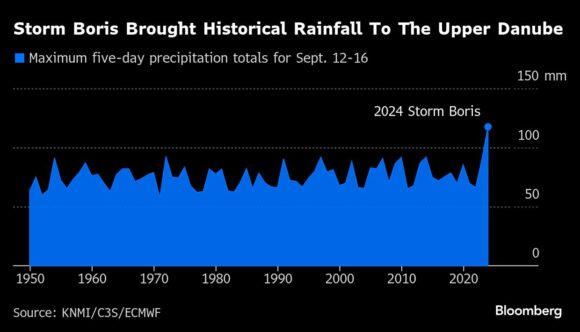Europe experienced the hottest year on record in 2024, as climate change combined with a strong El Niño to generate a series of extreme weather events and force glaciers into retreat.
Half the continent reported new heat records in 2024 and ocean temperatures in Europe were the highest ever recorded, scientists at the Copernicus Climate Change Service and World Meteorological Organization said in their annual analysis of the continent’s climate.
Since the 1980s, Europe has warmed twice as fast as the global average, pushing national leaders to intensify their efforts to strengthen early warning systems against extreme weather, according to WMO Secretary-General Celeste Saulo. The extra heat in the atmosphere and ocean likely supercharged storms last year, bringing some of the worst flooding to Europe in more than a decade.
“Every fraction of a degree matters,” said Saulo. “It matters in terms of risks to our economies, disruptions to our society, damage to our ecosystems.”
Higher European temperatures — 1.47C above normal — led to record rates of glacier mass loss in Scandinavia and Svalbard, the scientists found. That followed another year of extreme temperatures across the continent in 2023.

Powered by extra moisture in the atmosphere, Storm Boris brought three months of rain to parts of Germany, Italy, Poland, Romania and the Czech Republic in just four days in September. The deadly flooding overwhelmed the Danube, Elbe and Oder rivers, leading to what Gallagher Re estimated to be $20 billion in total losses. Later in the year, a slow-moving system dumped torrential rainfall on Valencia, Spain, killing more than 200 people and causing $11 billion in total losses, according to an analysis by Munich RE.

There was a sharp east-west divide in weather trends last year, scientists found. Countries in the east reported drier-than-normal conditions and southeastern Europe experienced 13 consecutive days of extreme heat in June, the longest heat wave on record.
That split also affected cloud cover and solar energy, scientists found.
Sunshine duration was 4% higher than normal across Europe in 2024, a change that was largely driven by clear skies in eastern countries — especially the Balkans, which saw hundreds more hours of sunshine than typical. By contrast, parts of the west were cloudier last year, with France having 350 fewer hours of sunshine than normal.
Wind speeds across the continent were generally near or below average last year, but renewable energy generation climbed to a record due to shorter periods with strong winds, higher sunshine and a growing number of turbines and solar panels.
Saulo said European leaders are strengthening early warning systems to alert people to the effects of extreme weather like floods and heat waves, but progress has been slow in some regions, including the southeast.
“We therefore need to go faster, we need to go farther,” she said.
Top photograph: Emergency service personnel help evacuate residents from the flooded town of Lewin Brzeski, southwestern Poland, on Tuesday, Sept. 17, 2024. Photo credit: Bartek Sadowski/Bloomberg
Topics Europe
Was this article valuable?
Here are more articles you may enjoy.



 Travelers Income Drops 65% on Catastrophe Losses, Primarily California Wildfires
Travelers Income Drops 65% on Catastrophe Losses, Primarily California Wildfires  Potential Tariff Auto Severity Impact on Travelers: Single-Digits or Less
Potential Tariff Auto Severity Impact on Travelers: Single-Digits or Less  Florida Bill Advances, Would End Board of Engineers, Other Professional Agencies
Florida Bill Advances, Would End Board of Engineers, Other Professional Agencies  Major Florida Grower to Build New Home Development After Ending Citrus Operations
Major Florida Grower to Build New Home Development After Ending Citrus Operations 

